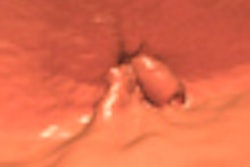
In results that run counter to a U.S. center's experience, Italian patients undergoing virtual colonoscopy screening won't wait three years for surveillance and follow-up of small polyps as an alternative to colonoscopy, according to a new study from the University of Pisa.
Indeed, most study patients either opted for immediate colonoscopy to remove the small polyps or came back for their next screening in much less than three years, according to the presentation at last month's 2011 European Congress of Radiology (ECR).
"Three years is quite a long follow-up time, and there is a lack of data on the adherence of patients to these recommendations," said Dr. Lorenzo Faggioni.
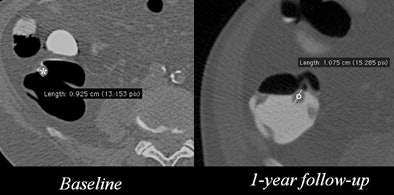 |
| Patient had a subcentimeter polyp in the ascending colon that grew to more than 1 cm after one year. Image courtesy of Dr. Lorenzo Faggioni. |
The study aimed to evaluate patients' preferences about follow-up of 6- to 9-mm polyps detected at screening virtual colonoscopy (also known as CT colonography or CTC).
Current guidelines call for at least three years of follow-up for lesions classified as C2 on the C-RADS scale (two or fewer 6- to 9-mm lesions) before re-examining the patient. In contrast, a larger U.S. study presented at the 2009 International Symposium on Virtual Colonoscopy found that most patients with C-RADS C2 lesions not only wanted surveillance, they stuck with their decision to wait for it.
"About two-thirds of patients with a C-RADS C2 finding in our CTC screening program opt for three-year CTC surveillance over polypectomy -- and most of them actually follow through with this plan," Dr. Perry Pickhardt from the University of Wisconsin said in an interview with AuntMinnie.com.
Almost 1,000 patients screened in Italy
In their ECR study, Faggioni and his University of Pisa team, including Dr. Emanuele Neri and Dr. Paola Vagli, examined 994 asymptomatic screening subjects ages 52 to 67 (mean, 61 years) referred for screening virtual colonoscopy. Of these, 193 (19.4%) were classified as C-RADS C2.
The patients were asked to complete a written informed consent document explaining the indications, technique, and potential complications of CTC. Patients then chose their preferred exam technique -- either CTC or optical colonoscopy -- and their follow-up interval by repeated consultations at three-month intervals.
In all, 87 (45.1%) of 193 C-RADS C2 patients accepted follow-up rather than immediate polyp removal. Of these, 42 (48.3%) chose CTC, while the remaining 45 (51.7%) chose conventional optical colonoscopy, Faggioni said.
The average time interval for follow-up was comparable between CTC (9.00 months ± 4.24) and optical colonoscopy (9.00 months ± 4.39) (p = 0.7188).
"Whether with CTC or optical colonoscopy, no patient chose to have a follow-up at the recommended time interval of three years, and most patients [n = 62] had follow-up at six months," Faggioni said.
VC surveillance of patients with C-RADS C-2 findings
|
There was no significant difference between the techniques used at any time interval, as well as no difference between the rate of preference for CTC or optical colonoscopy as a follow-up technique.
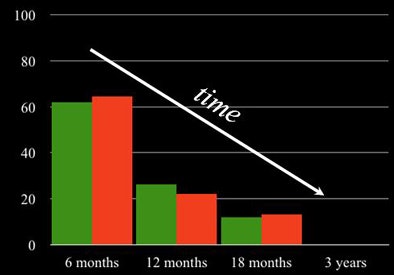 |
| CTC is depicted in green; optical colonoscopy is in red. Faggioni et al analyzed surveillance data using the Chi-square test with Yates' correction for continuity. The results showed that most patients chose follow-up with either CTC or optical colonoscopy before 18 months rather than later (χ2 = 12.66, p = 0.0004, and χ2 = 12.53, p = 0.0004, respectively). With either CTC or optical colonoscopy, no statistically significant difference was found between the ratios of patients undergoing follow-up before 18 months and from 18 months onward (χ2 = 0.01, p = 0.9203). Image courtesy of Dr. Lorenzo Faggioni. |
"But there was a clear trend of patients who had an early follow-up," Faggioni said. "A substantial fraction of surveillance patients prefer to undergo immediate optical colonoscopy and polyp removal rather than follow-up with either technique. The majority of patients accepting follow-up are willing to wait for a maximum of 12 months, so an 18-month follow-up period does not seem reasonable."
As a result of the findings, the group is suggesting that the proposed C-RADS C2 category be revised.
"A patient with a potentially malignant polyp doesn't want to take a chance -- he wants to have it removed to be sure," Faggioni said.
Willing to wait in Wisconsin
"Our experience has been very different," Dr. Perry Pickhardt said of the results from Faggioni and colleagues. Currently, approximately two-thirds of C-RADS C2 patients at the University of Wisconsin health center opt for three-year surveillance CTC -- and most of them don't change their minds midway through the surveillance period, he added.
The Wisconsin group's 2009 retrospective study, for example, looked at 5,334 asymptomatic adults who underwent CTC screening with a mean 54-month follow-up. When C-RADS C2 category findings were present, patients were given the option of same-day optical colonoscopy versus surveillance in one to two years, which was later changed to three years, Pickhardt said.
That study included the following patients:
- 406 (7.6%) of 5,334 with C-RADS C2 findings
- 125 (30.8%) who chose same-day or next-day endoscopy for polypectomy
- 243 (59.9%) who initially chose CTC surveillance on the day of the exam
- 38 (9.4%) who took no action or were undecided
"Of the 243 who initially chose CTC follow-up, 68 changed their minds and opted for immediate colonoscopy," Pickhardt said, adding that when patients did change their surveillance plans it was "most often due to the primary care physician talking their patients out of follow-up and into optical colonoscopy," he said.
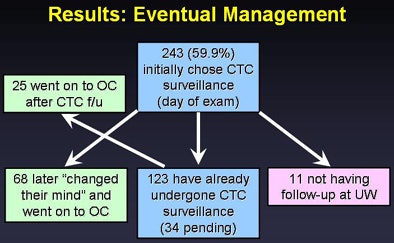 |
| Pickhardt et al analyzed the follow-up decisions in 406 (7.6%) of 5,334 screening subjects with C-RADS C2 findings. Most patients stuck to their original decision and completed their surveillance. Images courtesy of Dr. Perry Pickhardt. |
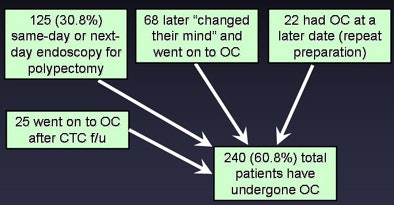 |
Importantly, the way information about optical and virtual colonoscopy is given to the patients can influence their decisions, Pickhardt said.
For example, in a survey of patients published in the American Journal of Medicine in July 2009, Dr. Jessica Shah and colleagues received responses from 305 patients regarding the hypothetical scenario of a finding a 5- to 8-mm polyp at CTC screening, Pickhardt said.
Asked if they would like to know if the polyp is "precancerous or cancerous," 95% answered "yes."
But that kind of "leading phraseology" can turn patients against surveillance, especially when the complications of optical colonoscopy are downplayed, he said. Also, a survey response indicating a willingness to undergo optical colonoscopy and actually having the exam are two very different end points, he added.
A separate survey of primary care physicians and gastroenterologists also found that a strong majority would refer such patients to optical colonoscopy, Pickhardt said. The results of larger studies on polyp surveillance are being evaluated.




